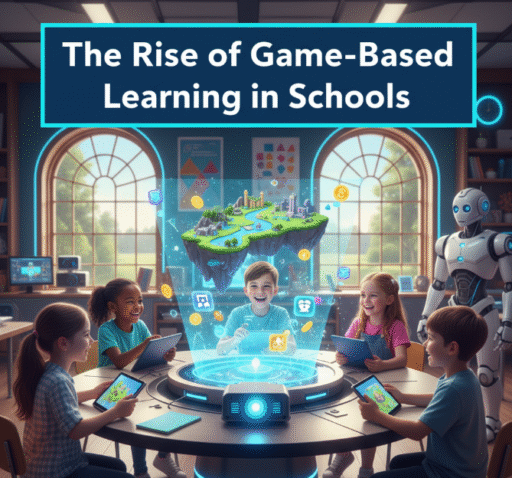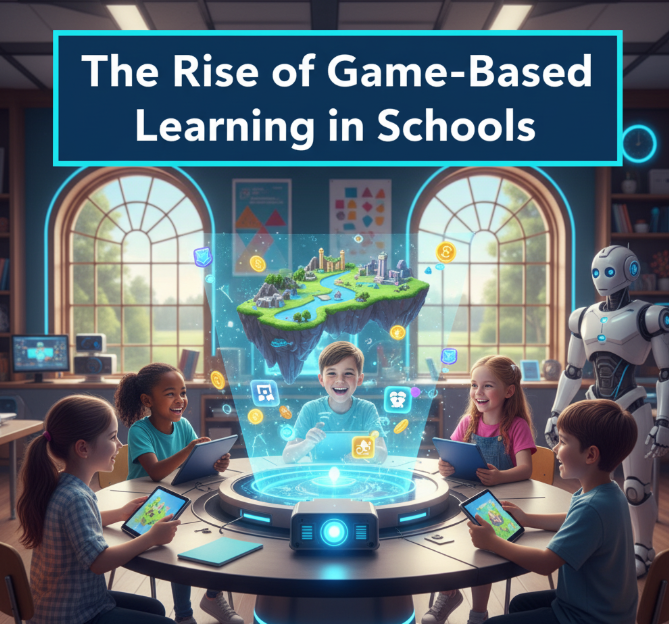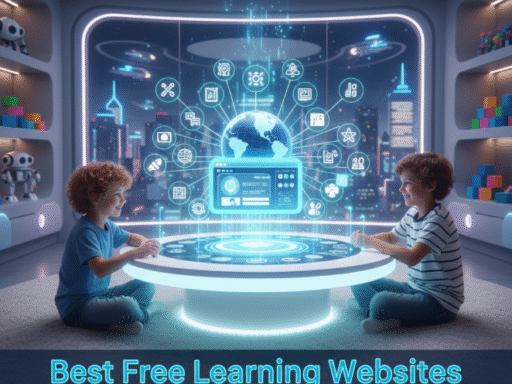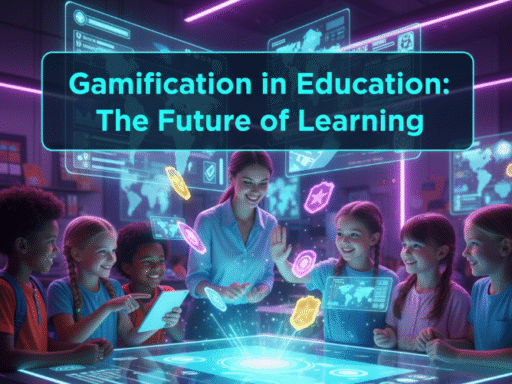Introduction: A New Way to Learn
Classrooms are no longer limited to chalkboards, textbooks, and lectures. Across the world, schools are transforming the way students learn by introducing game-based learning. This approach uses games—not just for fun—but as powerful educational tools that spark curiosity, strengthen problem-solving skills, and make learning more interactive.
From math puzzles to history role-playing adventures, game-based learning is capturing students’ attention in ways traditional methods sometimes cannot. Teachers are now recognizing that when students enjoy learning, they retain knowledge better and develop skills that go beyond memorization.
In this article, we’ll explore the rise of game-based learning in schools, why it matters, how it’s changing education, and what the future holds.
What is Game-Based Learning?
Game-based learning (GBL) is the use of games to teach academic subjects, life skills, or critical thinking in an engaging way. Unlike simply “playing games,” GBL is carefully designed to balance fun with learning goals.
Key Features of Game-Based Learning:
-
Interactive learning: Students take an active role instead of just listening.
-
Clear objectives: Each game is tied to specific learning outcomes.
-
Instant feedback: Players see the results of their decisions immediately.
-
Motivation through rewards: Points, levels, and achievements encourage persistence.
For example, a math game might challenge students to solve equations to advance to the next level, while a history game could simulate ancient civilizations to teach cause-and-effect relationships.
Why Schools are Turning to Game-Based Learning
Education systems are under pressure to prepare students for a fast-changing world. Traditional methods—lectures, rote memorization, and standardized testing—often leave students disengaged. Game-based learning provides an alternative that connects learning with real-world application and enjoyment.
Benefits for Students:
-
Increased Engagement – Games are naturally appealing and keep attention longer.
-
Better Retention – Students remember lessons learned through play more effectively.
-
Collaboration Skills – Many educational games require teamwork and communication.
-
Safe Failure Environment – Mistakes become part of the learning process, not punishments.
-
Critical Thinking Development – Strategy-based games improve reasoning and decision-making.
Benefits for Teachers:
-
Makes lessons more dynamic.
-
Provides instant data on student progress.
-
Reduces classroom disruptions by maintaining focus.
-
Allows teachers to adapt lessons to different learning styles.
A Brief History of Games in Education
While digital tools have made game-based learning more popular recently, the idea itself isn’t new.
| Decade | Milestone in Game-Based Learning |
|---|---|
| 1970s | Early educational computer games like The Oregon Trail introduced. |
| 1980s | Math and reading games gained popularity in classrooms. |
| 1990s | Multimedia CDs and PC-based learning games widely adopted. |
| 2000s | Internet access expanded online educational games. |
| 2010s | Mobile apps like Kahoot! and Prodigy changed classroom dynamics. |
| 2020s | Virtual reality (VR) and augmented reality (AR) bring immersive experiences. |
From board games to VR simulations, the tools have evolved, but the goal remains the same: make learning engaging and memorable.
Types of Game-Based Learning in Schools
1. Digital Game-Based Learning
-
Examples: Minecraft: Education Edition, Kahoot!, Duolingo.
-
Focuses on interactive digital environments that blend fun with knowledge.
2. Simulation Games
-
Examples: Flight simulators for science, business simulations for economics.
-
Allow students to experience real-world scenarios safely.
3. Role-Playing Games (RPGs)
-
Students take on roles (historical figures, scientists, entrepreneurs).
-
Encourages empathy, creativity, and deeper understanding.
4. Board and Card Games
-
Simple but powerful tools for math, vocabulary, and strategy.
-
Examples: Scrabble for language, chess for logic, Monopoly for economics.
5. Gamified Learning Platforms
-
Platforms where everyday lessons are structured like games.
-
Students earn badges, unlock levels, or compete in leaderboards.
Real-World Examples of Game-Based Learning
Case Study 1: Math Made Fun with Prodigy
-
Problem: Students found math boring and difficult.
-
Solution: A fantasy role-playing game where solving math problems lets characters progress.
-
Result: Increased participation, especially among students who struggled with traditional worksheets.
Case Study 2: History Through Role-Playing
-
Activity: Students reenacted the signing of the U.S. Constitution using a classroom simulation game.
-
Outcome: Higher recall of historical facts and improved debate skills.
Case Study 3: Science Experiments in VR
-
Tool: VR headsets for virtual chemistry labs.
-
Impact: Students safely experimented with reactions, reducing fear of failure while increasing interest in science.
Comparing Traditional vs. Game-Based Learning
| Aspect | Traditional Learning | Game-Based Learning |
|---|---|---|
| Engagement | Passive listening | Active participation |
| Feedback | Delayed (tests, grades) | Instant (in-game progress) |
| Motivation | External (grades) | Internal + external (fun + rewards) |
| Skills Developed | Memorization | Problem-solving, teamwork, creativity |
| Student Role | Receiver of information | Explorer, decision-maker |
This comparison shows why schools are shifting toward GBL—it builds skills beyond memorization.
Challenges of Game-Based Learning in Schools
While promising, GBL also has its challenges.
Main Challenges:
-
Cost of Technology – Not all schools can afford devices, VR tools, or software.
-
Training Teachers – Teachers need training to effectively integrate games.
-
Balancing Fun and Learning – Some games may prioritize fun without meeting learning objectives.
-
Screen Time Concerns – Excessive digital play raises health worries.
-
Curriculum Fit – Not all subjects are easily adaptable to games.
How Teachers Can Implement Game-Based Learning
Game-based learning doesn’t require expensive equipment or complex software. Even simple steps can make lessons more engaging.
Strategies for Teachers:
-
Start Small: Introduce one game per week to avoid overwhelming students.
-
Mix Digital and Physical Games: Use board games alongside digital platforms.
-
Align with Goals: Select games that directly support curriculum standards.
-
Encourage Collaboration: Use group games to build teamwork.
-
Gather Feedback: Ask students what games help them learn best.
Popular Tools and Platforms in Schools
Digital Platforms:
-
Kahoot! – Quiz-based learning with real-time participation.
-
Prodigy Math – Role-playing math game.
-
Quizizz – Interactive quizzes with competitive features.
-
Minecraft: Education Edition – Virtual world for creativity and problem-solving.
Physical Tools:
-
Board games for vocabulary, math, and social studies.
-
Card games to teach quick thinking and memory.
-
Escape room activities for problem-solving and teamwork.
Student Perspective: Why Kids Love Game-Based Learning
Students report that games make learning:
-
More enjoyable
-
Less stressful
-
More interactive
-
A chance to learn by doing instead of only listening
A middle school student once said, “When I play math games, I forget I’m even doing math—it just feels like an adventure.”
This captures the essence of GBL—it transforms learning into something students look forward to.
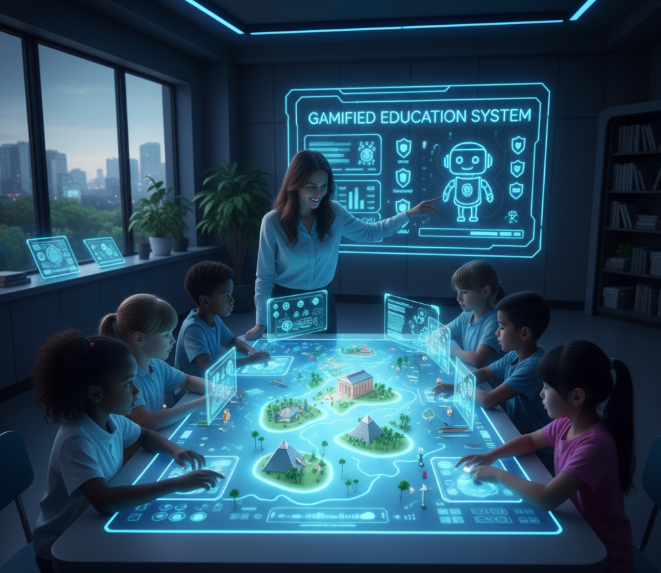
Parents’ Role in Game-Based Learning
Parents sometimes worry that games distract from academics. But when used properly, games can strengthen skills beyond the classroom.
How Parents Can Support:
-
Monitor screen time and balance online/offline activities.
-
Ask children what they learned through a game.
-
Play educational board games together at home.
-
Encourage healthy competition in learning games.
The Future of Game-Based Learning
Technology continues to evolve, and with it, game-based learning will only expand.
Emerging Trends:
-
Virtual Reality Classrooms – Full immersion into subjects like history and science.
-
Artificial Intelligence Tutors – Personalized feedback and adaptive challenges.
-
Augmented Reality Learning – Digital overlays in real-world classrooms.
-
Global Collaboration Games – Students from different countries learning together.
By 2030, experts predict that game-based learning will be a standard part of education, not just an optional tool.
Tips for Schools Adopting Game-Based Learning
-
Invest wisely: Choose cost-effective tools with proven results.
-
Provide teacher training: Successful integration depends on skilled educators.
-
Focus on balance: Use GBL alongside traditional methods.
-
Measure impact: Track student progress to evaluate effectiveness.
Infographic: Key Advantages of Game-Based Learning
📊 (Describe infographic for clarity)
-
Engagement ↑ 70%
-
Retention ↑ 60%
-
Collaboration ↑ 50%
-
Critical Thinking ↑ 65%
This demonstrates the measurable improvement schools have seen with GBL.
Conclusion: Learning Through Play is Here to Stay
The rise of game-based learning in schools represents more than just a trend—it’s a revolution in education. By turning lessons into interactive experiences, schools are preparing students for a future where creativity, problem-solving, and adaptability matter most.
When games are used wisely, they don’t replace learning—they enhance it. They make classrooms places of discovery, excitement, and growth.
As schools continue to adopt game-based strategies, one thing is clear: the future of learning is not just about books and tests—it’s about play, participation, and progress.
